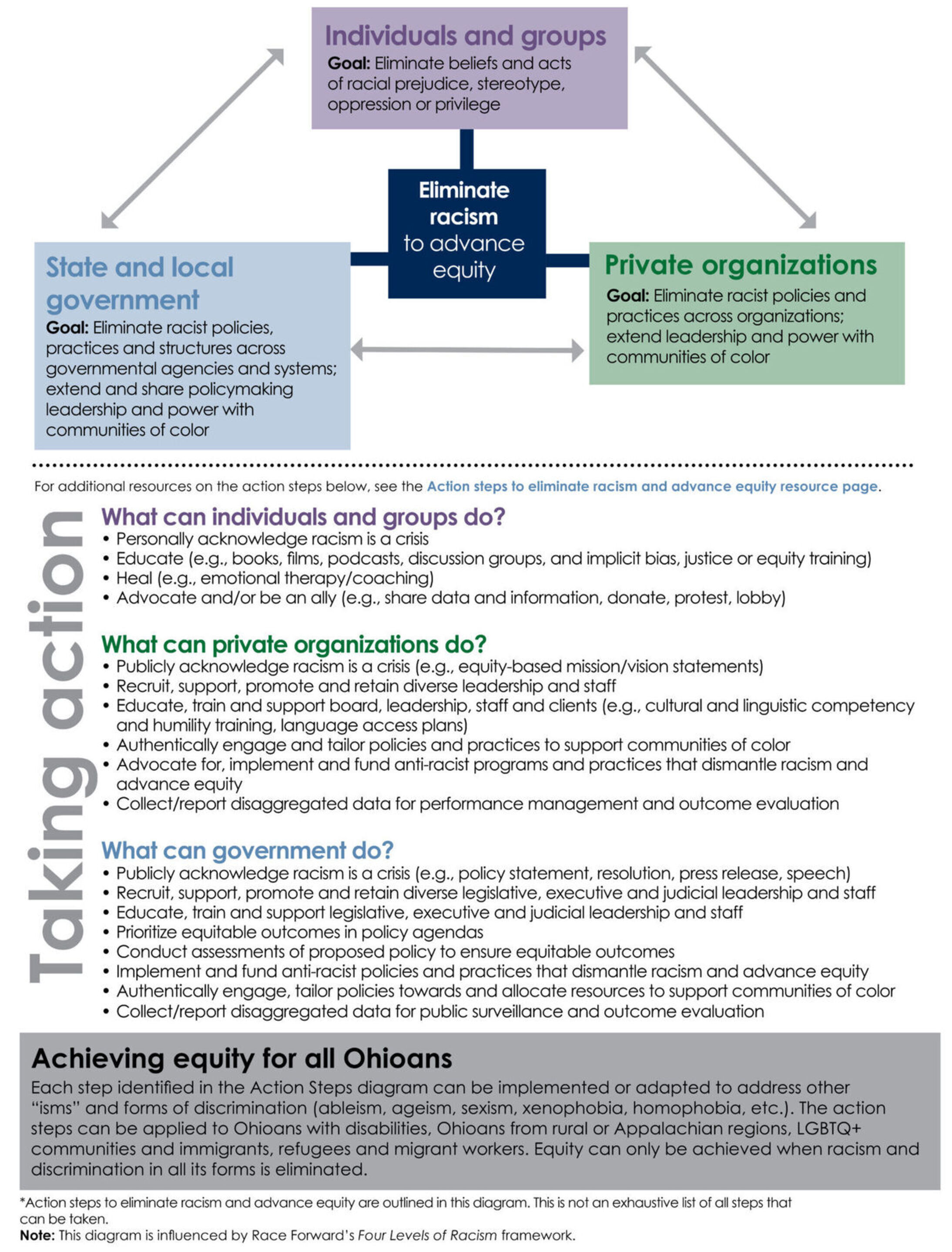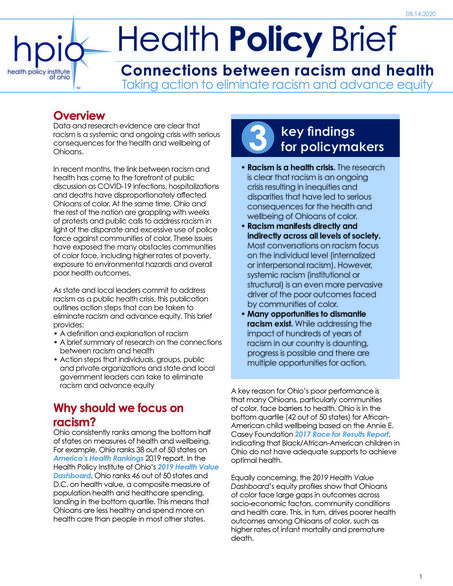Connections between racism and health:
Taking action to eliminate racism and advance equity
Overview
Data and research evidence are clear that racism is a systemic and ongoing crisis with serious consequences for the health and wellbeing of Ohioans.
In recent months, the link between racism and health has come to the forefront of public discussion as COVID-19 infections, hospitalizations and deaths have disproportionately affected Ohioans of color. At the same time, Ohio and the rest of the nation are grappling with weeks of protests and public calls to address racism in light of the disparate and excessive use of police force against communities of color. These issues have exposed the many obstacles communities of color face, including higher rates of poverty, exposure to environmental hazards and overall poor health outcomes.
As state and local leaders commit to address racism as a public health crisis, this publication outlines action steps that can be taken to eliminate racism and advance equity. This brief provides:
- A definition and explanation of racism
- A brief summary of research on the connections between racism and health
- Action steps that individuals, groups, private organizations and state and local government leaders can take to eliminate racism and advance equity
3 key findings for policymakers
- Racism is a health crisis. The research is clear that racism is an ongoing crisis resulting in inequities and disparities that have led to serious consequences for the health and wellbeing of Ohioans of color.
- Racism manifests directly and indirectly across all levels of society. Most conversations on racism focus on the individual level (internalized or interpersonal racism). However, systemic racism (institutional or structural) is an even more pervasive driver of the poor outcomes faced by communities of color.
- Many opportunities to dismantle racism exist. While addressing the impact of hundreds of years of racism in our country is daunting, progress is possible and there are multiple opportunities for action

Figure 6. Action steps to eliminate racism and advance equity
Why should we focus on racism?
Ohio consistently ranks among the bottom half of states on measures of health and wellbeing. For example, Ohio ranks 38 out of 50 states on America’s Health Rankings 2019 report. In the Health Policy Institute of Ohio’s 2019 Health Value Dashboard, Ohio ranks 46 out of 50 states and D.C. on health value, a composite measure of population health and healthcare spending, landing in the bottom quartile. This means that Ohioans are less healthy and spend more on health care than people in most other states.
A key reason for Ohio’s poor performance is that many Ohioans, particularly communities of color, face barriers to health. Ohio is in the bottom quartile (42 out of 50 states) for African-American child wellbeing based on the Annie E. Casey Foundation 2017 Race for Results Report, indicating that Black/African-American children in Ohio do not have adequate supports to achieve optimal health.
Equally concerning, the 2019 Health Value Dashboard’s equity profiles show that Ohioans of color face large gaps in outcomes across socio-economic factors, community conditions and health care. This, in turn, drives poorer health outcomes among Ohioans of color, such as higher rates of infant mortality and premature death.
How can racism be eliminated?
All Ohioans should have the opportunity to reach their full health potential. Yet, racism has been an obstacle to good health for communities of color in the U.S. for more than four hundred years. Addressing the cumulative impact of historical and present-day racism is daunting. However, progress is possible and there are opportunities to dismantle racism at every level of society.
HPIO adapted the Four Levels of Racism Framework (see figure 1) to create Action Steps to Eliminate Racism and Advance Equity (figure 6). The diagram outlines how individuals and groups, private organizations and state and local government leaders can work to eliminate racism in all its forms and advance equity.
Taking action
The goals and action steps outlined in the Action Steps diagram address the different levels of racism:
- Internalized and interpersonal racism are reflected in the goal and action steps outlined for individuals and groups. For example, interpersonal racism can be reduced by educating oneself on issues about racism and participating in implicit bias or equity trainings.
- Institutional and structural racism are reflected in the goals and action steps for private organizations and state and local governments. Action steps that can be taken to combat institutional and structural racism include strategically allocating resources to support communities of color, prioritizing equitable outcomes for communities of color and collecting/reporting disaggregated data for performance management, public surveillance and outcome evaluation.
All Ohioans, private organizations and state and local government entities should act on the following themes to eliminate racism:
- Acknowledge racism as a crisis. Explicitly acknowledging racism and the profound effect it has on communities of color sets a level of honesty and accountability that is necessary to engage in equity conversations.
- Rebuild community trust. Racist beliefs, policies and practices have, over time, deteriorated the level of trust communities of color hold in current leaders, systems and structures. Efforts to eliminate racism require rebuilding community trust through authentic community engagement, collaboration and leadership, providing robust opportunities for participation in the democratic process and transparent and accessible decision-making. It is also important to recognize that communities of color are not a monolithic group and represent many diverse perspectives. Fostering an inclusive culture of dialogue can honor this diversity, support efforts to rebuild community trust and ensure that the needs of communities of color are met.
- Extend and share power. A concerted effort should be made to extend and share power with communities of color. This includes partnering on each aspect of a decision-making process, including final decision-making.48 Communities of color are not passive in this process and can also take steps to lift voices from their communities and empower themselves and one another.
- Sustain efforts over time. Systemic change is difficult. Sustained efforts across all levels of racism are necessary to overcome the status quo and eliminate existing, deep-seated racist beliefs, interactions, policies, practices and structures within society. Work to eliminate racism is both repetitive and incremental. Future action can reinforce previous action steps and/or lead to additional conversation, reflection and dialogue.
More resources
HPIO resources
- Publication graphics (Powerpoint)
- Publication graphics (PDF)
- Connections between racism and health: Private sector organizations
- Connections between racism and health: State and local policymakers
- Action Steps to Eliminate Racism resource page
- Connections between criminal justice and health: Insights on justice and race
- HPIO health equity work
State plan examples
- COVID-19 Ohio Minority Health Strike Force Blueprint
- Ohio’s Executive Response: A Plan of Action to Advance Equity
- 2020-2022 State Health Improvement Plan
- 2020-2022 Strategic Action Plan on Aging
- 2020-2025 Ohio Commission on Minority Health Strategic Plan
Local plan examples
- Franklin County Rise Together Blueprint
- 2016-2020 Cuyahoga County Board of Health Strategic Plan
- City of Akron Racial Equity and Social Justice Taskforce Quarter 1 and Quarter 2 reports
- City of Dublin Diversity, Equity and Inclusion Framework
By:
Amy Rohling McGee, MSW
Nick Wiselogel, MA
Carrie Almasi, MPA
Reem Aly, JD, MHA
Published On
August 14, 2020
Table of Contents
 Download Publication
Download Publication
